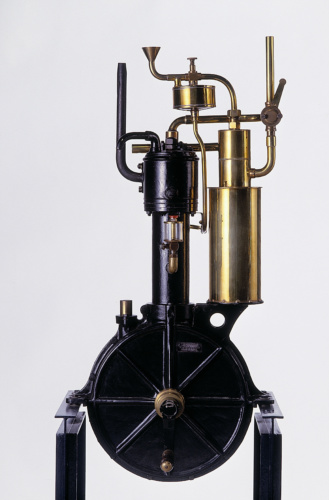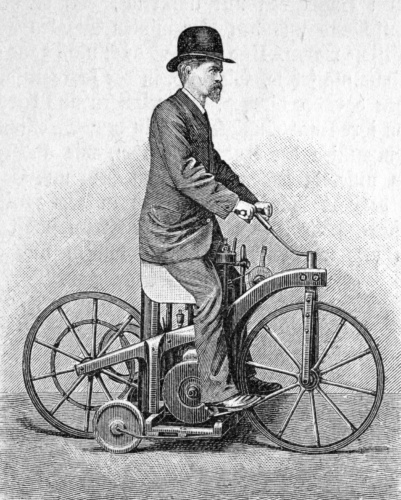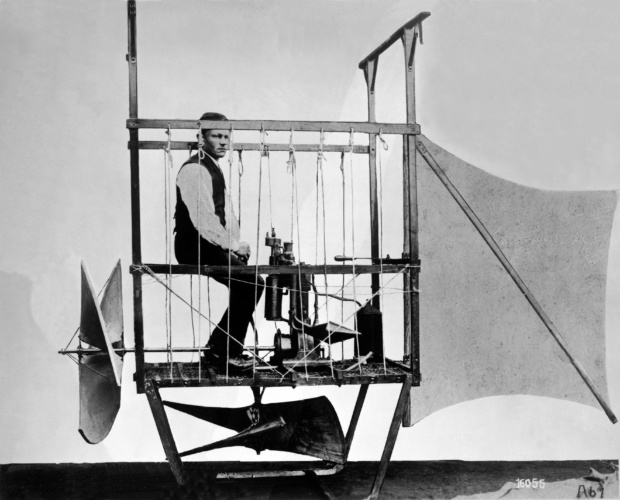Gottlieb Daimler, 1878. Image: Daimler
While there can be no definitive statement as to who built the original automobile, there is a consensus supported by the Library of Congress that the first petrol-powered, four-wheeled, four-stroke engine ‘horseless carriage’ was brought into this world by Gottlieb Daimler. Whether or not the German engineer, designer and industrialist was beaten in the race to by his fellow countryman and automotive engineer Carl Benz is a matter of debate prompted mostly by what definition of ‘car’ is used. But what is beyond dispute is that these two great pioneers of the modern motor vehicle would become forever associated with each other when in June 1926 the world’s oldest motor manufacturers, Daimler Motoren Gesellschaft (DMG) and Benz & Cie., merged to create Daimler-Benz AG, the company behind the prestige marque Mercedes-Benz. The first part of this name has a somewhat convoluted origin, derived from the pseudonym – Mercédès – of Austrian racing driver Emil Jellinek (who competed in DMG cars), who had adopted the mononym in honour of his daughter.

The four-stroke engine developed by Gottlieb Daimler and Wilhelm Maybach, nicknamed Grandfather Clock. The first unit ran successfully in 1884. Image: Daimler
Gottlieb Wilhelm Daimler was born on 17 March 1834 in the small town of Schorndorf in the Kingdom of Württemberg that is now in southern Germany. There were very few clues in his early life that the baker’s son who had spent six years of his youth at the local Lateinschule (where, as its name suggests, he learned Latin), would rise to such prominence in the world of engineering that his hometown would later become informally known as Die Daimlerstadt, or ‘Daimler Town’. And yet, the young Daimler was sufficiently interested in mechanical engineering to enter an apprenticeship as a gunsmith, from which he qualified in 1852 having produced a pair of engraved double-barrelled pistols. It was in this year that he changed course and enrolled at Stuttgart’s School for Advanced Training in the Industrial Arts, and after a brief stint at local locomotive manufacturer (where he became foreman at the age of 22), Daimler returned to academia. This time he attended Stuttgart’s Polytechnic Institute where, upon gaining a thorough knowledge steam engines, he decided that this technology (in light industrial applications at least) was going to be replaced by machines that were simpler, cheaper and powered by something other than a boiler.
“The best or nothing at all.”
Gottlieb Daimler (1834-1900)
By the early 1860s Daimler had moved to England where he worked in heavy industry and in 1862 attended the Great London Exposition in South Kensington where saw a steam carriage. Unimpressed, Daimler returned to his homeland, where for much of the remainder of the decade he worked at the Christian Socialist toolmaker Bruderhaus Reutlingen, the most significant aspect of which was his meeting with a 15-year-old orphan by the name of Wilhelm Maybach, who was to become not only a continual presence in a partnership with Daimler that was to last until the end of the century, but would also emerge as one of the greats of automotive design.
It’s not until the 1870s that Daimler’s career in engine technology started to take off. In 1872 he joined Gasmotorenfabrik Deutz as technical director, selected by the management over company founder Nicolaus Otto (himself one of the main players in the development of the internal combustion engine). Maybach was soon brought in as chief designer, and the team worked on developing Otto’s petrol fuelled, compressed charge four-stroke cycle, (the eponymous ‘Otto Cycle’). With so many creative minds under one roof it’s hardly surprising that there were soon factions competing over the direction in which to take innovation, prompting Daimler into taking legal action to challenge one of the company’s own patents, effectively liberating the intellectual property for his own creative pursuits as a freelancer. Perhaps inevitably, in 1880 Otto fired Daimler amid speculation that the former was jealous of the latter’s university education. Daimler was compensated for the patents that bore his name, and in a case of history repeating itself, Maybach followed Daimler out of the door.

A circa 1888 wood engraving of the Daimler Reitwagen- one of the first vehicles to be powered by an internal combustion engine. BILDAGENTUR-ONLINE / TH FOTO / SCIENCE PHOTO LIBRARY
The money from Deutz allowed Daimler to establish a workshop in Cannstatt, where he and Maybach set about miniaturising Otto’s four-stroke petrol engine with a view to making it more suited to mobile use, while pondering how best to fuel it. It was during this time that, the team developed their ‘Dream Engine’ that gradually evolved over three incarnations to run at up to 900 rpm, that was started with an electrical ignition designed by Bosch. By 1885 a flywheel (‘Grandfather Clock’) version of the design was built into a two-wheel vehicle called the ‘Reitwagen’ (‘riding car’) that was, according to Len Larson’s book Dreams to Automobiles, the first vehicle to be powered by an internal combustion engine, although arguably that honour could apply to a design by Carl Benz, working independently merely 60 miles away in Mannheim, whose ‘motorwagen’ was granted a patent on 26 January 1886.
One thing is clear, and that is the degree of frenzied activity at Cannstatt was such that Daimler and Maybach were drawing unwanted attention to themselves from neighbours, who suspected that the engineers were running a counterfeiting racket from their highly secret workshop. The local constabulary was raised and the premised were raided, but the only artefacts the police found were engines. These were the engines that, in the words of today’s official Daimler website, had “revolutionised engine design and made it possible for the first time to power a wide variety of vehicles: in 1885 the wooden motorcycle, in 1886 the motorboat and motorised carriage, in 1887 the trolley car, a miniature streetcar and the motorised rail locomotive,” as well as the ‘dirigible’ (or ‘steerable’) balloon. One of the lesser-known facts about Daimler’s career is that he single-handedly ushered in a new era of aeronautics, when on 10 August 1888 the first engine-driven flight was achieved in an airship belonging to the Leipzig-based bookseller Dr Friedrich Hermann Wölfert. Powered by a single-cylinder Daimler engine, its success completed Daimler’s cherished dream of motorising vehicles on land, on water and in the air. These three applications of the technology came to be symbolised in the Daimler logo of the three-pointed star.

Dr Karl Wölfert aboard the first engine-powered airship. The drive system was the famous single-cylinder Daimler engine with an output of 2 hp (1.5 kW) which powered two propellers: one in a vertical position and the other horizontal. Image: Daimler
By this time, Daimler’s production ambitions were expanding, and with the workshop now drawing the disapproval of the local mayor, he relocated the operation to a larger facility with room for 23 employees at Seelberg Hill, some distance from the town. This was where Daimler and Maybach delivered their ‘Strahlradwagen’ (loosely translated as ‘jet wheel cart’), which was noteworthy in that it was the first such design not to be based on the horse-drawn carriage.
From a business point of view, perhaps more importantly it was during this period that Daimler sold the first foreign licenses for their engines, with Maybach travelling to France to present their achievements at the 1889 Paris Exposition, where one newspaper reported that, “off in this hidden corner… was germinating the seed of a modern technological revolution.” While the public took little notice of the innovation, it attracted the attention of the newly founded French manufacturer Panhard et Levassor, who sold their first automobile based on a Daimler engine license in 1890. The engine was also manufactured in the US, Austria and the United Kingdom under the management of Daimler’s friend Frederick Simms. With production underway, Daimler’s engine became the foundation for the development of motorised transportation as we know it today. When he was inducted into the Automotive Hall of Fame in 1979, the citation included the famous newspaper quotation.
By the 1890s demand for engines was growing and Daimler was able to expand his business by raising venture capital from the gunpowder and munitions sectors. Daimler Motoren Gesellschaft was established with Maybach once again the right-hand man. But the experience was not a happy one for the man whose company bore his name. Having gone into business with two equal share partners – Max Duttenhofer and Wilhelm Lorenz – he was unable to obtain majority control over the company and watched powerless as DMG moved away from automobile production and into stationary engine production. Daimler sold his stock and resigned, and when Maybach was denied a seat on the board, he resigned too.
The two men beat a retreat to Cannstatt in 1893 where they became freelance car engine designers once more, continuing with their experimental development. They entered endurance trials and road races with engines that routinely defeated DMG products. Such was his enduring influence that Daimler was brought back into the company at Frederick Simms’ insistence, with Maybach following, both men receiving substantial compensation in the form of company shares. Although his return was beset by ill health, Daimler survived to the end of the century, departing this mortal coil on 6 March 1900.
Source: https://www.theengineer.co.uk
CUT COTS OF THE FLEET WITH OUR AUDIT PROGRAM
The audit is a key tool to know the overall status and provide the analysis, the assessment, the advice, the suggestions and the actions to take in order to cut costs and increase the efficiency and efficacy of the fleet. We propose the following fleet management audit.




